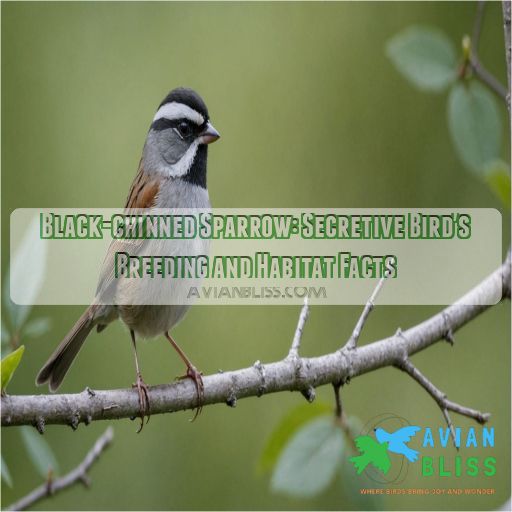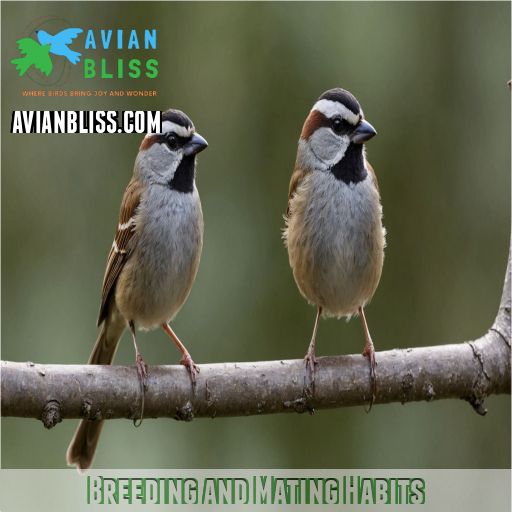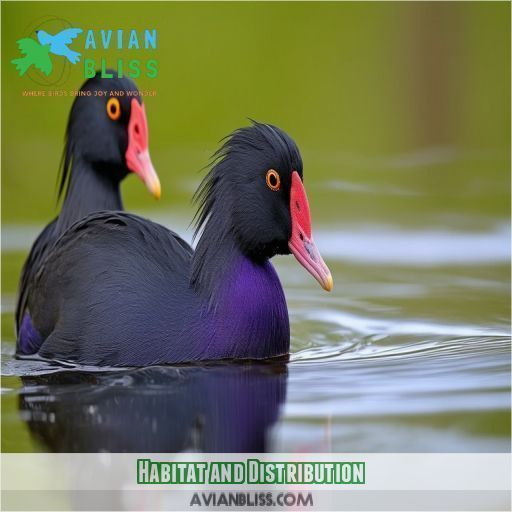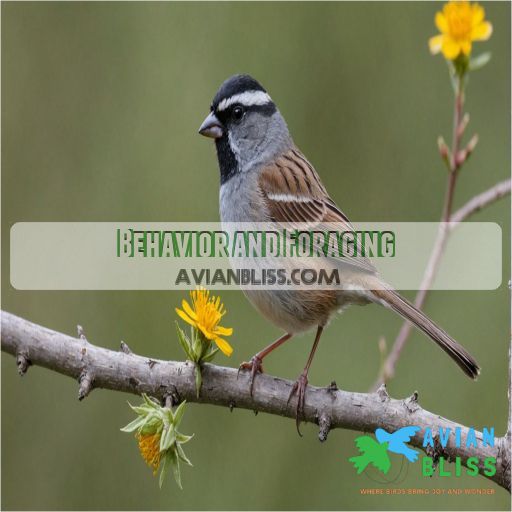This site is supported by our readers. We may earn a commission, at no cost to you, if you purchase through links.

These sparrows, akin to secretive rock stars, form loose colonies where males croon territorial tunes and tend to their young. They’re ground foragers by day, shy dancers in dense scrubs during the breeding season.
Though climate change looms as a storm cloud, their numbers remain stable, for now. Curious to know what makes them tick or how they stay one step ahead of troubles? Read on!
Table Of Contents
- Key Takeaways
- Black Chinned Sparrow Identification
- Breeding and Mating Habits
- Habitat and Distribution
- Behavior and Foraging
- Conservation Status and Threats
- Frequently Asked Questions (FAQs)
- What is the difference between a black-chinned and a Black-throated Sparrow?
- What is the black-chinned sparrow habitat?
- Where do black sparrows live?
- What is the difference between a dark eyed junco and a sparrow?
- What is the lifespan of the Black-chinned Sparrow?
- How does the Black-chinned Sparrows diet change throughout the year?
- What are the main threats to the Black-chinned Sparrow besides climate change?
- How does the Black-chinned Sparrows population size compare to other sparrow species?
- What adaptations help the Black-chinned Sparrow survive in its arid habitat?
- Conclusion
Key Takeaways
- You might spot the black-chinned sparrow strutting its unique look, with a gray head and a striking black chin, in males during breeding season, in the arid southwestern hills. It’s like finding a feathered treasure chest in a desert wonderland.
- These sparrows are like secret rock stars, staying low-key as they sing territorial tunes and forage on the ground by day. They’re all about that birdie hustle, forming small colonies and being stealthy foragers in dense scrubs.
- climate change is a looming threat, but the Black-chinned Sparrow is holding steady in its dance with nature. Think of it as a desert survivor that adapts like a pro, camouflaging itself in harsh, scrubby terrains.
- If you’re hoping to catch these sparrows in action, look out for their winter gatherings in small flocks, pecking at seeds like they’re at a backyard barbecue. They migrate to Mexico and the southern US, proving they’re true seasonal travelers adjusting to a changing world.
Black Chinned Sparrow Identification
You’ll find the Black-chinned Sparrow to be a charming little bird, sporting a gray head and chest with a pale bill and sporting back-and-wing patterns like a Chipping Sparrow.
Breeding males flaunt their distinctive black chin and facial pattern, a look they wear just in time for the mating season.
Small Long-tailed Bird Characteristics
The Black-chinned Sparrow is a diminutive, long-tailed bird that calls the arid southwestern hills home. Its compact size, measuring just 5-5 1/2 inches, is complemented by a distinctive patterning on its back and wings reminiscent of a Chipping Sparrow.
The bird’s defining feature is the bold black chin sported by breeding males, a trait absent in females and juveniles.
- Small, compact size
- Long tail for its diminutive frame
- Chipping Sparrow-like wing and back patterning
- Black chin on breeding males
Gray Head and Chest With Pale Bill
Spotting this little fellow feels like finding a puzzle piece!
With a bill coloration that’s pale and unassuming, you might first think it’s a Junco’s cousin.
Its gray plumage covers the head and chest, and it almost seems like the bird’s wearing a muted costume.
If birds had fashion shows, this Black-chinned Sparrow might just showcase "casual with flair.
Back and Wings Patterned Like Chipping Sparrow
You’ve noticed the gray head and chest, now keep your eyes peeled for the wings that echo a Chipping Sparrow.
This Black-chinned Sparrow presents a wonderful bird identification challenge with its striking mix of colors and patterns, like those found in Michigan’s diverse bird population.
While exploring the arid hills, imagine a bird museum where field marks are the ultimate exhibition in pattern variation.
Black Chin Present on Breeding Males
Imagine a male Black-chinned Sparrow sporting its signature black chin—a hallmark of its breeding season attire. This unique characteristic plays a key role in its life:
- It’s all about that evolutionary edge.
- Serves as a bold mating display.
- Highlights seasonal change.
- Sparks intrigue from females.
Feathered fashion, anyone? It’s seasonal plumage variation at its finest!
Distinctive Facial Pattern During Breeding Season
During the breeding season, male Black-chinned Sparrows sport a distinctive facial pattern that’s absent in females and juveniles.
This striking feature, acquired just before mating, helps them attract mates and assert dominance.
Females find this facial display irresistible, as it signals the male’s fitness and breeding readiness.
Enjoy observing this avian courtship ritual in action!
Breeding and Mating Habits
When you spot a Black-chinned Sparrow, you’ll notice the males singing their hearts out to claim territory in their small loose colonies.
The females handle incubation duties, laying three to four light greenish-blue eggs in well-hidden nests tucked close to the ground.
Small Loose Colonies With Males Singing to Defend Territory
In the enchanting world of Black-chinned Sparrows, males gather in small, loose colonies.
They become maestros, singing territorial songs to ward off rivals and attract mates.
This breeding behavior creates a vibrant symphony where colony dynamics, nesting competition, and mate selection come alive.
These feathered performers showcase a natural balance of charm and cunning, making their communities both lively and competitive.
Nest Site in Low Shrub Close to Ground
When choosing a nest site, Black-chinned Sparrows show a penchant for low shrubs close to the ground.
This choice helps with predator avoidance and provides camouflage.
These crafty birds use ground nesting adaptations to their advantage, creating sheltered homes.
It’s like picking the perfect neighborhood — safe, cozy, and using nest materials like dry grasses and weed stems.
Female Lays 3-4 Light Greenish to Blue Eggs
The female Black-chinned Sparrow lays a clutch of 3-4 light greenish to blue eggs, sometimes lightly dotted with dark brown.
These delicate eggs are the foundation for the next generation of this secretive bird.
With patience and care, the female will incubate the eggs for 12-13 days, ensuring the hatchlings have the best start in life.
Both Parents Bring Food to Young, Female Incubates Eggs
Parental care is all about teamwork! Once the eggs are laid, the female takes the lead in incubation while both parents pitch in to feed the nestlings. It’s a delicate dance of nesting behavior where each partner pulls their weight.
Speaking of surprises, ever hear of brood parasitism? These sparrows dodge that trap, keeping their young safe.
| Aspect | Detail |
|---|---|
| Incubation | Female primarily incubates |
| Feeding | Both parents feed nestlings |
| Nesting Threat | Rarely affected by brood parasitism |
Habitat and Distribution
As you explore the Black-chinned Sparrow’s world, picture it nesting in the arid southwestern hills, hidden among dense low scrub and steep hillsides.
In winter, these shy birds keep you guessing as they forage in small flocks across the ground, retreating to northern Mexico and the southern US.
Arid Southwestern Hills and Mountains
You’re exploring arid southwestern hills and mountains, home to Black-chinned Sparrows, rich with desert wildflowers and unique mountain ecosystems.
These habitats aren’t just breathtaking; they’re key to the sparrows’ survival.
But climate change’s relentless march can pose wildlife threats.
So, conservation efforts become personal quests to preserve both sparrows’ unique charm and our natural playground.
Isn’t nature just the ultimate showstopper?
Dense Low Scrub and Steep Hillsides
The Black-chinned Sparrow makes its home in the rugged terrain of the Southwest, nesting in the dense low scrub and steep hillsides. This secretive bird thrives in these challenging environments, skillfully moving through the rocky slopes and tangled vegetation. Its camouflaged plumage blends seamlessly with the surroundings, allowing it to remain elusive and undisturbed.
Adaptability to harsh conditions is a hallmark of this species.
- Rugged, unforgiving terrain
- Camouflage and stealth
- Adaptability to harsh conditions
- Resourcefulness in finding nesting sites
- Resilience in the face of environmental challenges
Wintering Grounds in Northern Mexico and Southern US
As Black-chinned Sparrows embrace the dense low scrub and steep hillsides, they eventually make their way to the wintering grounds of northern Mexico and the southern U.S.
Climate impact subtly nudges their migration patterns.
With a winter diet of seeds and insects, they adapt to changing habitats.
Conservation efforts help make sure you’re part of protecting these seasonal travelers.
Small Flocks Form in Winter, Foraging on Ground
Picture yourself bundled up against the chill, watching Black-chinned Sparrows exhibit their winter foraging behavior. These little explorers:
- Form small, loose flocks, reminiscent of a casual get-together.
- Engage in ground feeding habits, pecking for seeds like it’s a treasure hunt.
- Embrace dynamic flock dynamics, adapting to winter habitats in search of nourishing food sources.
They’re winter’s understated charm.
Behavior and Foraging
When watching Black-chinned Sparrows, you’ve got to appreciate their stealth; these shy birds move slowly, foraging on the ground or in low shrubs.
Black-chinned Sparrows are elusive, especially during breeding season.
If you’re lucky, you might catch a view of them hanging out with other sparrows, but don’t expect a flashy show.
Foraging on Ground, Moving Slowly in Limited Area
As you observe the Black-chinned Sparrow, you’ll notice it forages slowly and methodically on the ground, carefully scanning for its preferred food sources. This shy bird tends to stay within a limited area, moving deliberately through the dense low scrub that makes up its arid southwestern habitat. Its ground-based foraging is a key part of its survival strategy.
Foraging Behavior is characterized by slow, deliberate movement and a focus on ground-level foraging.
The Black-chinned Sparrow’s limited foraging area helps it to efficiently use the resources within its arid habitat.
| Foraging Behavior | Food Sources |
|---|---|
| Slow, deliberate movement | Seeds, insects, berries |
| Limited to ground-level | Adapted to arid environment |
| Focused within small area | Efficient use of resources |
Also Forages in Low Shrubs and Small Flocks
While on the ground, Black-chinned Sparrows stick to low shrubs, hunting for snacks like they’re on a treasure hunt.
They join small flocks, adding a social twist to their foraging strategies.
These birds adjust flock dynamics based on seasonal variations, showing savvy shrub preferences.
It’s like a backyard barbecue in their habitat, gathering with friends to share nature’s buffet.
Often With Other Sparrows, Sometimes With Other Bird Species
Flocking behavior keeps Black-chinned Sparrows busy, as they often mingle in mixed species gatherings.
Imagine this: you’re watching a bird party and notice these sparrows socializing with fellow birds. They’re like the charming hosts who:
- Exchange tweets with sparrow groups.
- Network within bird communities.
- Enjoy social interactions.
- Befriend diverse creatures in their habitat.
What a lively social life!
Shy Nature, Particularly During Breeding Season
It’s all about the quiet life. Even when mingling with sparrows, the Black-chinned Sparrow cherishes its privacy, especially during breeding.
Like a star shunning the paparazzi, it slips into dense shrubs.
With territories secured through soft songs, males focus on responsible parenthood. Caring for their young is their serenade, embracing the hush of nature’s nurturing embrace.
Conservation Status and Threats
The Black-chinned Sparrow is fairly common in its habitat and has stable population numbers.
However, climate change-driven threats could impact its range and survival, so it’s important to understand this secretive bird’s vulnerability.
Fairly Common in Habitat, With Stable Numbers
You’re walking through the hills and spot a Black-chinned Sparrow flitting about, feeling like a secret society member.
Don’t worry, these little guys are fairly common in their arid homes.
Despite their shy demeanor, their population trends remain stable.
Habitat loss isn’t a showstopper yet, but keeping an eye on conservation efforts helps these birdie buddies stick around.
Climate Change-Driven Threats to Range and Population
Climate change is a double-edged sword, impacting Black-chinned Sparrows through habitat loss and food scarcity.
Picture them as reluctant travelers, adjusting to a range shift due to drought impacts.
Conservation efforts aim to preserve their habitat, but like a game of musical chairs, resources are shrinking.
Balancing these challenges requires creativity and cooperation to secure their future.
Not Currently Considered Threatened or Endangered
You might think Black-chinned Sparrows are living on the edge, given all that climate change talk.
But fear not; they’re not currently considered threatened or endangered.
Thanks to stable population trends, these sparrows are holding their ground.
Of course, conservation efforts have a role in protecting their habitat to make sure a chirpy future outlook!
Rare Host of the Brown-Headed Cowbird
Occasionally, the Black-chinned Sparrow falls victim to the Brown-headed Cowbird’s brood parasitism. These sneaky birds lay their eggs in the sparrow’s nest, forcing the unsuspecting parents to raise the cowbird chick as they often do.
To defend against this, sparrows may:
- Abandon the nest
- Bury the cowbird egg
- Build a new nest on top of the old one
- Aggressively chase away the cowbird
Vulnerability to Climate Change and Human Activities
While being a rare host to the pesky Brown-Headed Cowbird, the Black-chinned Sparrow faces challenges.
Habitat loss and range shifts leave them scrambling like nervous musicians on a moving stage.
Food scarcity and limited water access add to their to-do list.
Shifting species interactions, in turn, make for unpredictable antics. It’s a bird juggling an ever-changing world.
Frequently Asked Questions (FAQs)
What is the difference between a black-chinned and a Black-throated Sparrow?
Black-chinned Sparrows have pale bills and black chins on breeding males, resembling juncoes.
Black-throated Sparrows sport an iconic black throat year-round and bold white eyebrow stripes, creating a more striking appearance in the arid landscapes they roam.
What is the black-chinned sparrow habitat?
Imagine calling a scrub-filled mountainside your home!
You’d find Black-chinned Sparrows nesting on steep hillsides or foraging in winter flocks on the ground, typically among low shrubs in arid regions across the southwestern United States.
Where do black sparrows live?
Black sparrows love calling the arid hills of the southwestern U.S. their home.
They hide in dense scrub on steep slopes from California to Texas, even dipping into Mexico.
They’re shy but enjoy forming small winter flocks.
What is the difference between a dark eyed junco and a sparrow?
Ah, the age-old conundrum – dark-eyed juncos and sparrows, two peas in a pod, yet worlds apart! You see, juncos sport a sleek, uniform look, while sparrows flaunt a more intricate, speckled ensemble. It’s a matter of style, my friend.
What is the lifespan of the Black-chinned Sparrow?
While there’s no definitive lifespan data for Black-chinned Sparrows in the provided contexts, small sparrows generally live a few years, with some reaching five to seven years, given good conditions and evading predators .
How does the Black-chinned Sparrows diet change throughout the year?
You might think their diet changes drastically, but it doesn’t.
Throughout the year, they mainly forage on the ground, munching on seeds and insects.
Imagine them as tiny, feathered chefs whipping up seasonal specialties!
What are the main threats to the Black-chinned Sparrow besides climate change?
Besides climate change, Black-chinned Sparrows face threats like grazing, habitat loss due to urban development, and being rare hosts of Brown-headed Cowbirds, which sneakily lay eggs in sparrow nests, putting a strain on their parenting.
Brown-headed Cowbirds sneakily lay eggs in sparrow nests, putting a strain on their parenting.
How does the Black-chinned Sparrows population size compare to other sparrow species?
Ah, the Black-chinned Sparrow – a feisty little fella, ain’t it?
While it may not be as numerous as its more boisterous cousins, this shy bird holds its own in the sparrow kingdom.
Steady as she goes, my friend.
What adaptations help the Black-chinned Sparrow survive in its arid habitat?
Imagine moving through a rugged landscape with grace; Black-chinned Sparrows do just that.
They’re masters of camouflage with their grayish-brown tones.
Their ground-foraging habits and altitudinal movements help them thrive in their arid habitats .
Conclusion
Imagine the Black-chinned Sparrow as a rock star, shyly crooning from its desert stage.
You can’t help but be charmed by its subtle grace and the intriguing life it leads in the arid southwest.
With its stable numbers, this understated bird thrives in the face of climate challenges, continuing its secretive foraging and nesting.
So, next time you’re in their turf, keep your eyes peeled for the Black-chinned Sparrow’s understated yet encompassing allure.








